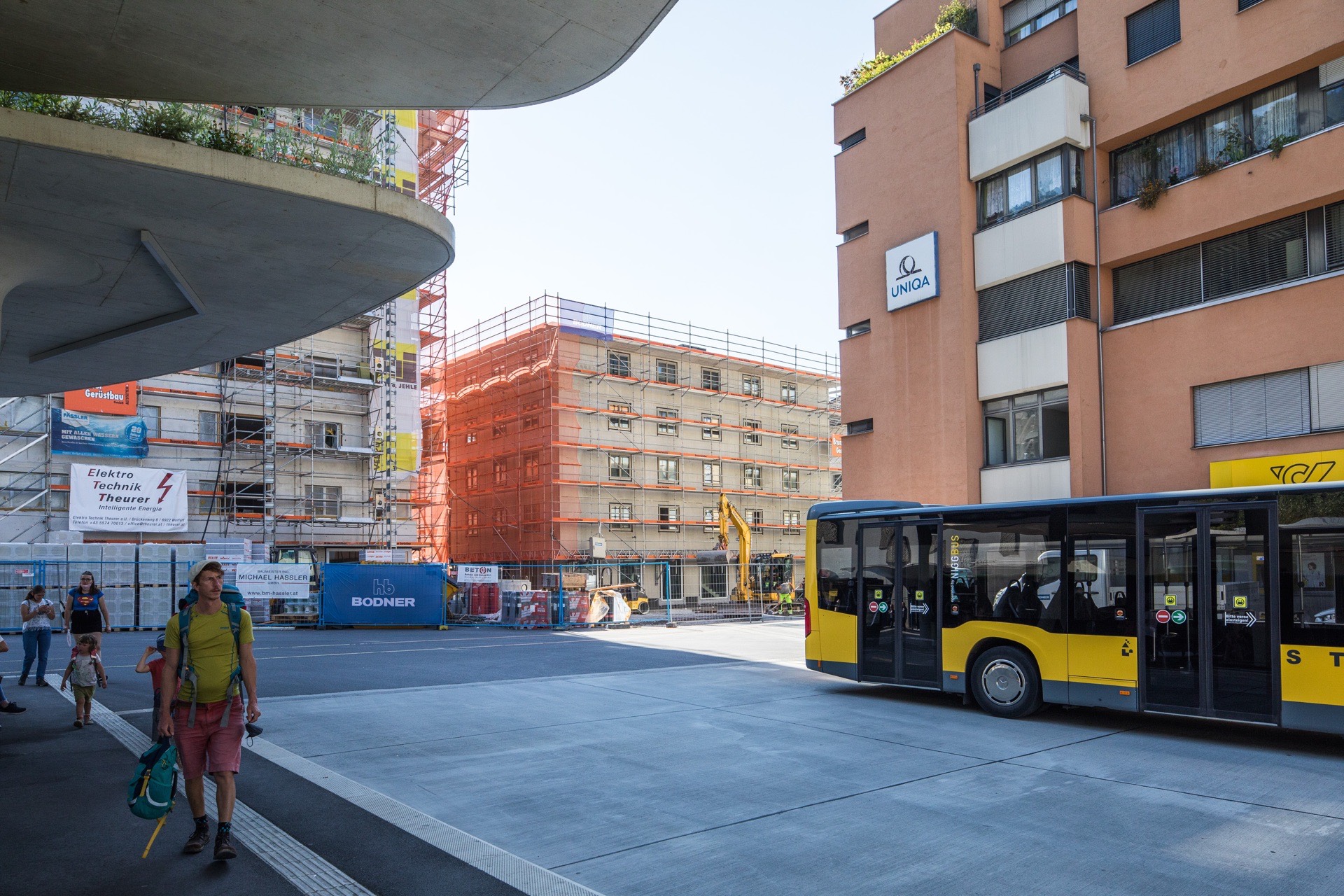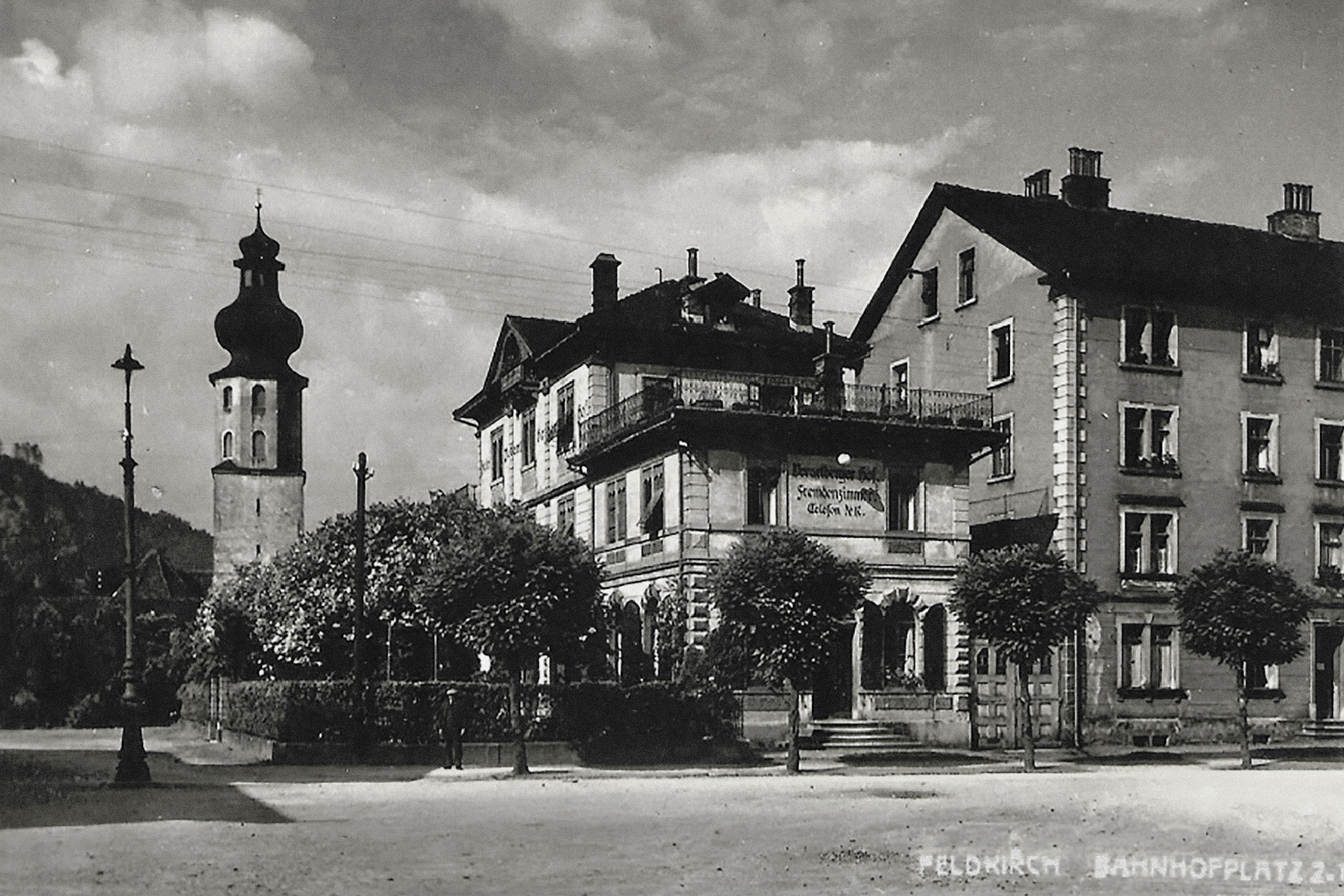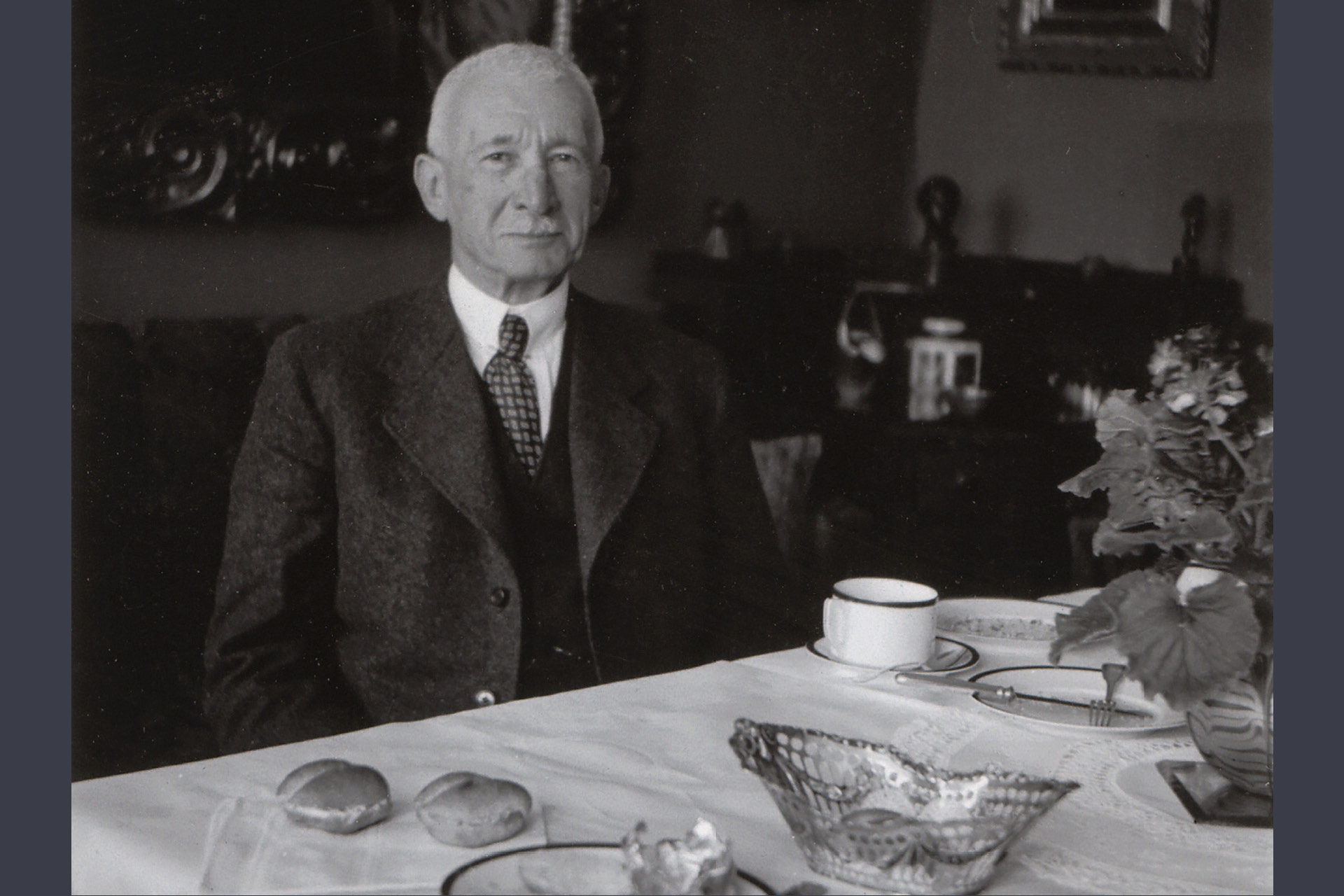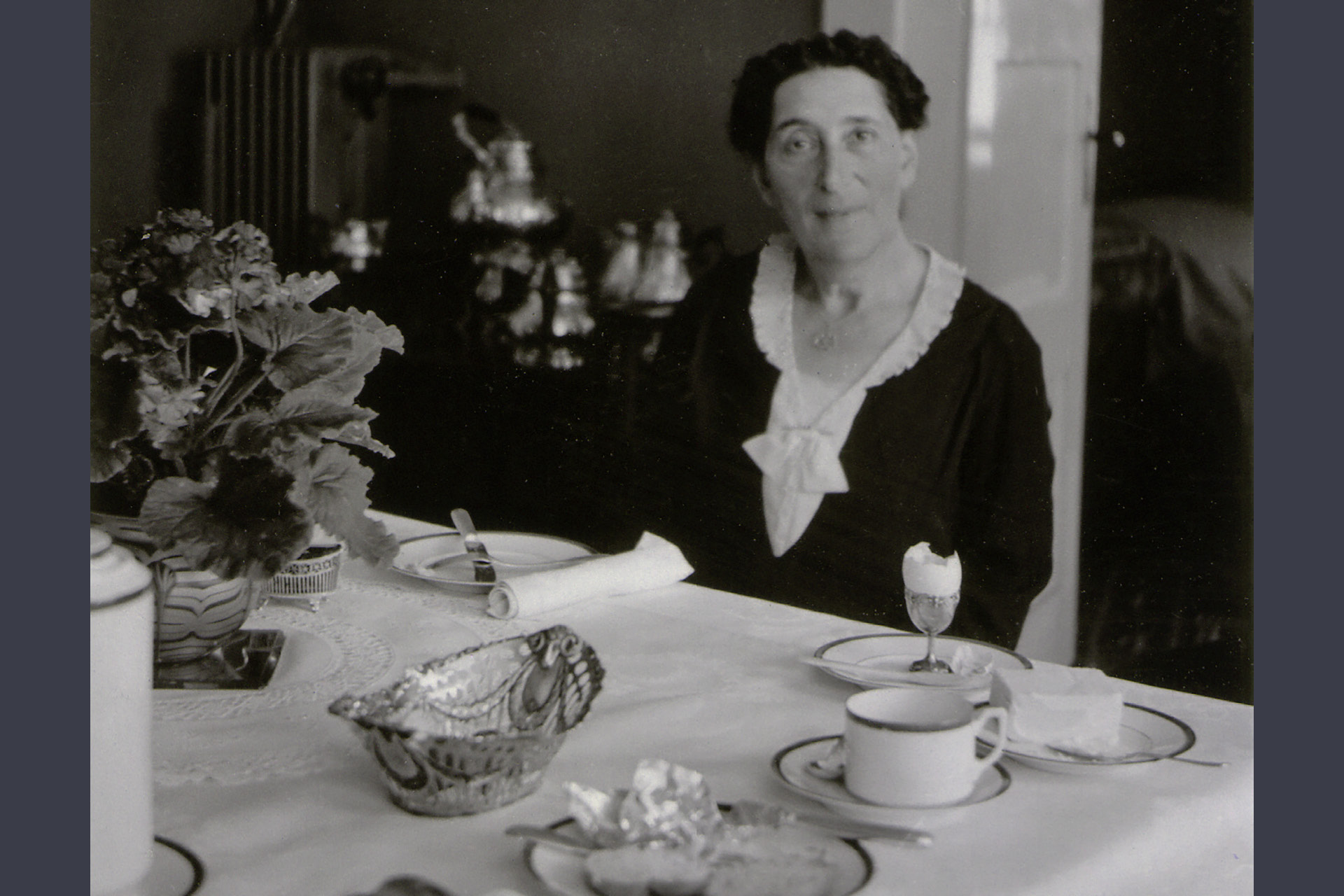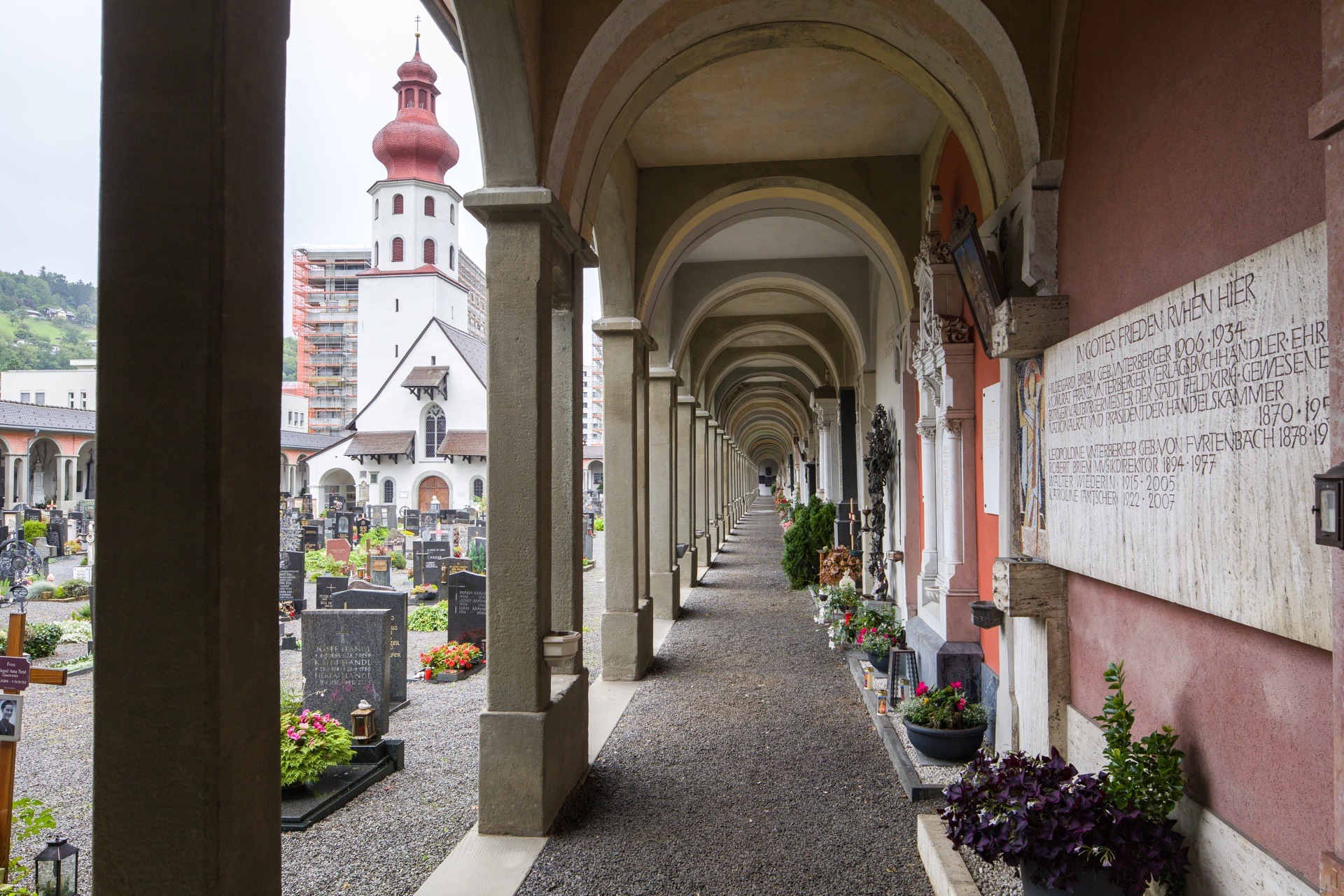Michael and Emmy Schnebel> November 13, 1938
42 Michael und Emmy Schnebel
“We think it is better to die in the Fatherland”. Michael and Emmy Schnebel take their own lives in the Vorarlbergerhof
Feldkirch, November 13, 1938
On November 10, two travellers from Garmisch-Partenkirchen arrive in Feldkirch. They take a double room in the Hotel Vorarlbergerhof, next to the train station. On the evening of November 13, the hotel staff opens the room because the two guests have not been seen for two days.
That same evening, the gendarmerie post writes a report to the district administration:
“Feldkirch, November 13, 1938.
Dr. Michael Schnebel arrived here with his wife from Garmisch-Partenkirchen on November 10, 1938. Since they had no travel documents, they were prohibited from their intended departure to Switzerland. They rented a room in the Vorarlbergerhof. Since the people were last seen in the house on the evening of November 11, the locked room was opened today, November 13, at 7 p.m., and Schnebel and his wife were found dead in their beds.
The farewell letters found and four glass jars, each containing 10 pieces of veronal tablets, undoubtedly indicate suicide. The physician, Dr. Schwärzler, ordered the transfer of the bodies to the mortuary at the city hospital. Cash funds to cover funeral expenses are available.
The report was sent to the district administration, the public prosecutor's office in Feldkirch and the provincial gendarmerie command in Bregenz. (Not for the press!).“[1]
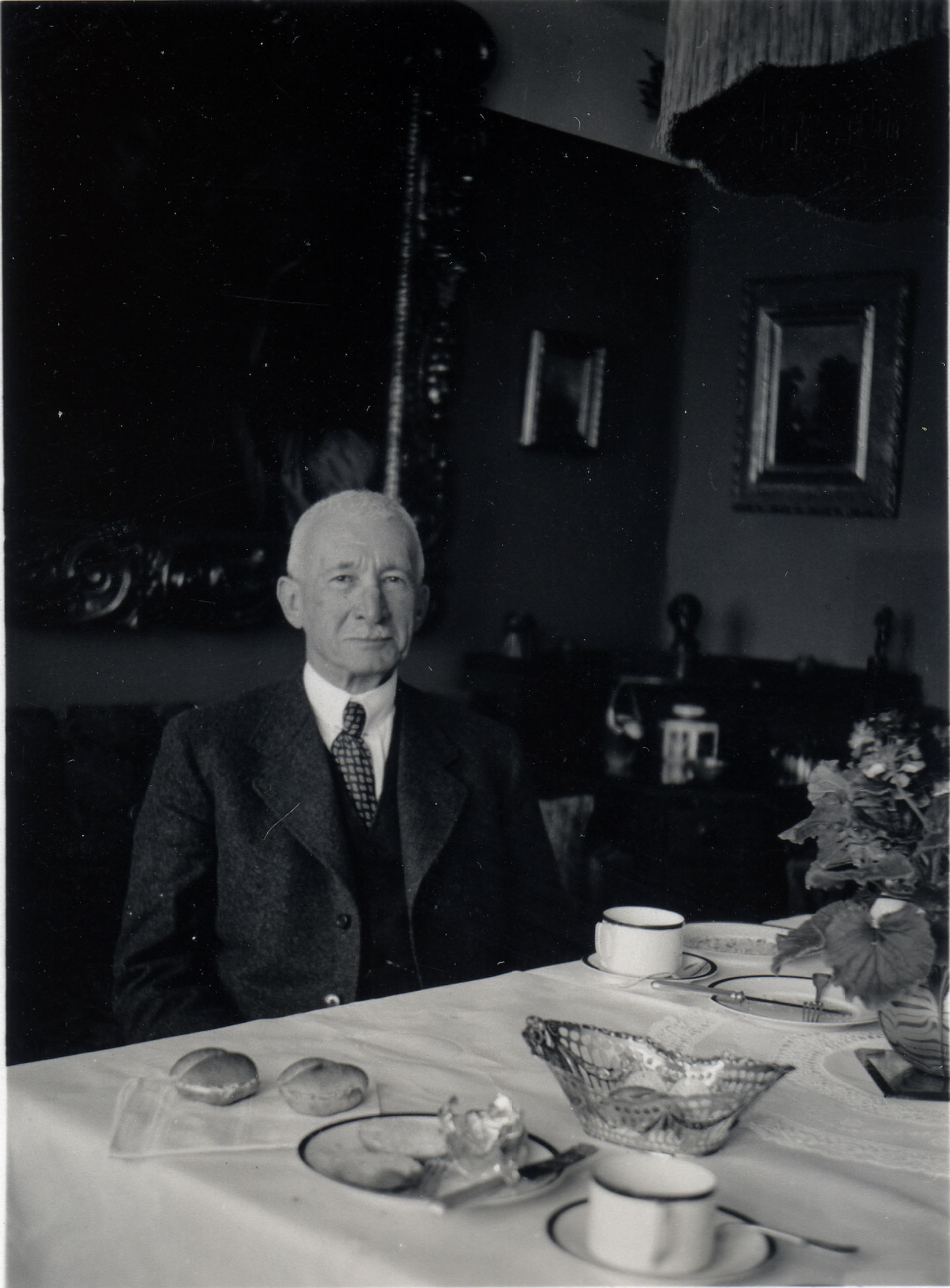
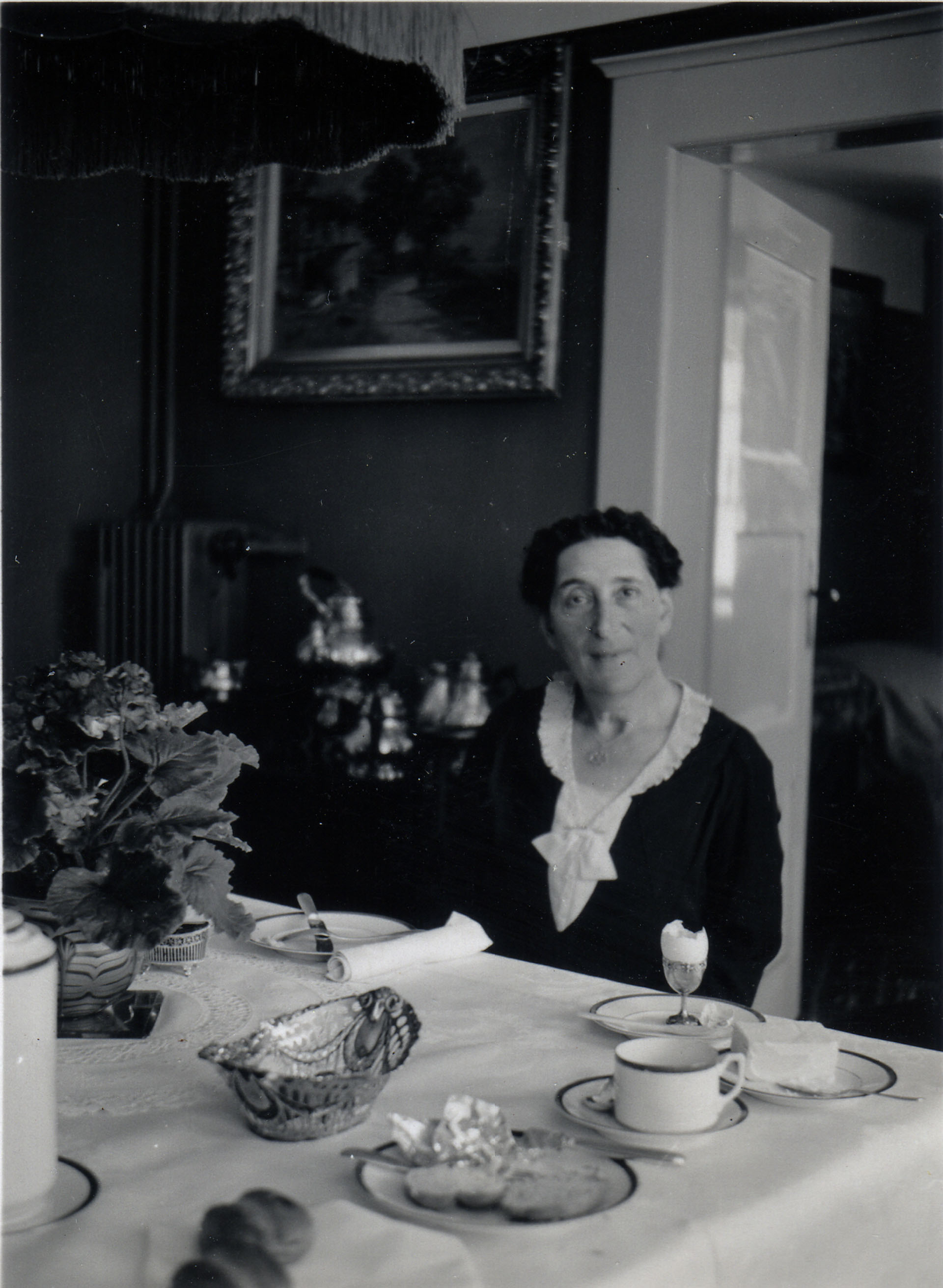
Michael and Emmy Schnebel
Michael Schnebel is 71 years old at the time of his suicide. Until 1930, he did worked at Munich University as a historian of ancient history and expert in papyrus research. Then he had retired to Garmisch-Partenkirchen with his wife Emmy.
Both were known for their self-deprecating humor and their love of German literature.
On November 10, 1938, a National Socialist mob marches through the streets of Garmisch-Partenkirchen. The Jewish inhabitants of the town are chased from their homes, insulted and spat upon. The Nazi district leader, Johann Hausböck, forces them to sign a lapel that they “leave Garmisch-Partenkirchen on the next available train and never return.” They must agree to sell their property, all “land, buildings and goods immediately from (their) new place of residence to an Aryan.”[2]
An SA man accompanies them to the train station. Michael and Emmy Schnebel were allowed to pack one more suitcase. Their apartment is sealed. An employee of the residents' registration office later notes on their registration card: “Since the Jewish Action unknown where moved to.”
In their farewell letter in the Feldkirch hotel room, the two write:
“It is best that we leave the world.” (...) “we consider it better to die in the fatherland than to be destitute in a foreign country. Like Cicero, we ask to be allowed to die in our fatherland.”[3]
They are initially buried in the Catholic cemetery of St. Peter and Paul, directly behind the hotel where they took their own lives.
A few days later, a student of the seminar for ancient history turns to the Garmisch-Partenkirchen police. On November 24, 1938, he writes:
“As it has been pointed out to me, in earlier years Dr. Schnebel, a Jew who has recently been living in Garmisch, Waxensteinstr. 1, worked at the Papyrology seminar of the University of Munich and collected scholarly material that could be of value. Since there is now reason to believe that the Jew is no longer in Germany and that his apartment is subject to confiscation, I request you, on behalf of the Papyrology seminar, to send the above-mentioned material, which is completely worthless for laymen, to the Papyrology seminar of the University of Munich, if this is possible. It is probably available in the form of slips of paper and notes stored in card file boxes and cigar boxes, etc. Since the series of scholarly contributions to which Schnebel contributed in the 1920s Munich Review of Papyrus research (Münchener Beiträge zur Papyrusforschung) is to be continued, we would attach great importance to coming into possession of these securely existing records. If you can assist us in word and deed to make this possible, we would be very grateful for your efforts. Heil Hitler!”
The 23 year old student Franz Strauß, who was so eager to obtain the scientific estate of Michael Schnebel, was apparently well informed about the expulsions from Garmisch, possibly also put on Schnebel's papers by his own doctoral advisor. In addition to his studies, he himself was active in the National Socialist Motorist Corps as an ideology consultant, called “Weltanschaulicher Referent”, in Sturm 23/M86. He became known not as a papyrus researcher, but as a long-time CSU chairman and Bavarian prime minister, under his full name Franz Josef Strauß.
Michael and Emmy Schnebel's last resting place should not remain in Feldkirch. A file note from the market town office in Hohenems and a note in the grave book of the St. Peter and Paul cemetery indicate that in April 1949 the remains of the two were moved to the Jewish cemetery in Hohenems. The exact location of their grave is unknown.[4]
Recommended reading:
Alfons Dür, “‘Es ist das Beste, dass wir aus der Welt gehen‘ - Der jüdische Althistoriker Dr. Michael Schnebel und seine Frau Emma Schnebel wählen am 14. November 1938 in Feldkirch den Freitod“, in: Montfort. Zeitschrift für Geschichte Vorarlbergs, 74th Jg., 2022, vol. 1, pp. 67-78.
[1] Incident report by the Feldkirch gendarmerie post command of 13.11.1938, VLA BH Feldkirch Abt. The Date is not clear. The typoscript shows the 14th later corrected into the 13th.
[2] https://www.gapgeschichte.de/juden_in_gap_biographien/schnebel_dr.michael_emma.htm
[3] Quoted after: https://www.gapgeschichte.de/juden_in_gap_biographien/schnebel_dr.michael_emma.htm
[4] Hohenems Municipal Archives Box 69 Number 123_11-B; St. Peter and Paul's burial book, Archive of the Diocese of Feldkirch.
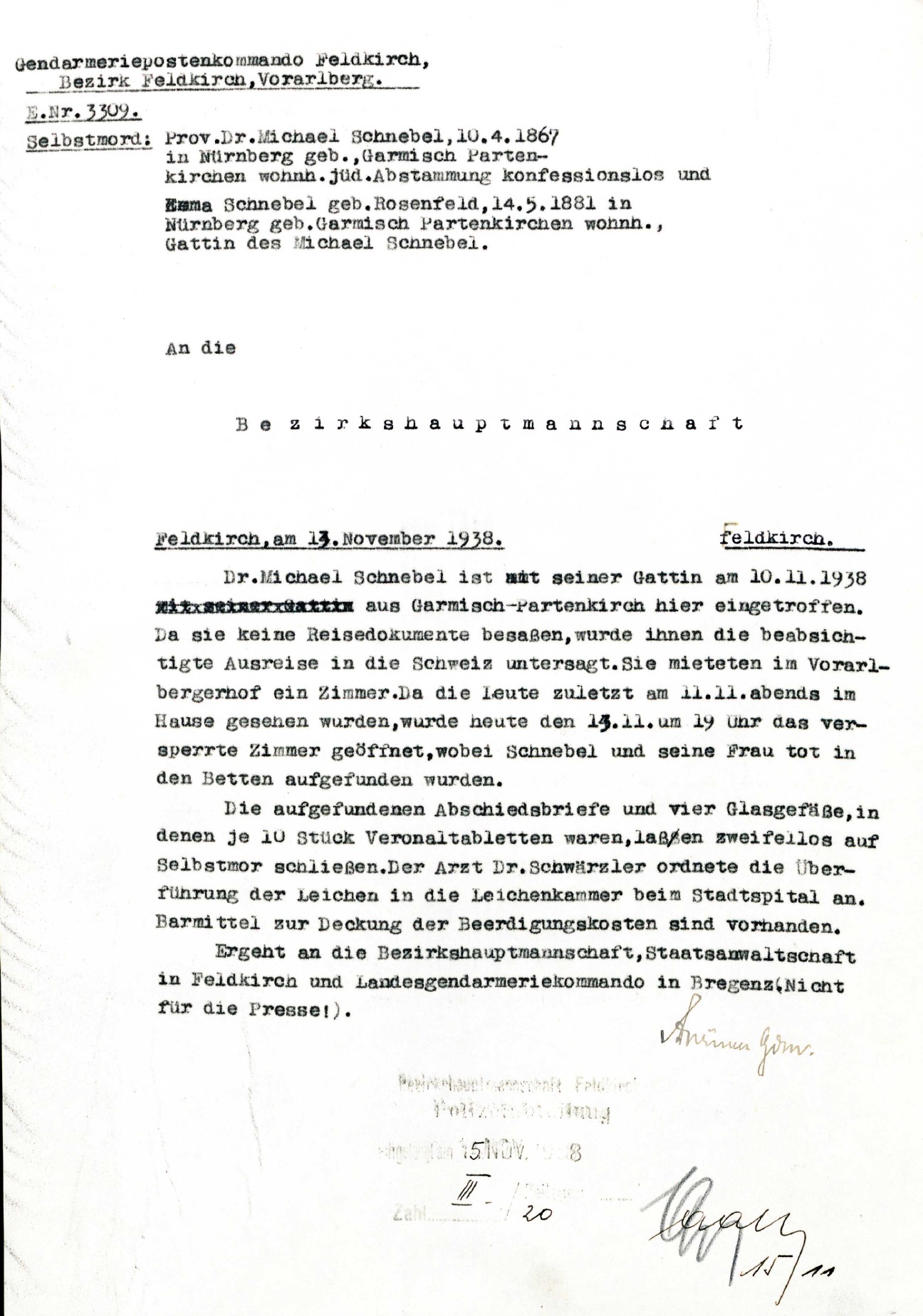
Report of the Feldkirch Gendarmerie Post Command to the District Headquarters, November 13, 1938
Feldkirch District Administration, Dept. III, Incident Reports, 20-1938
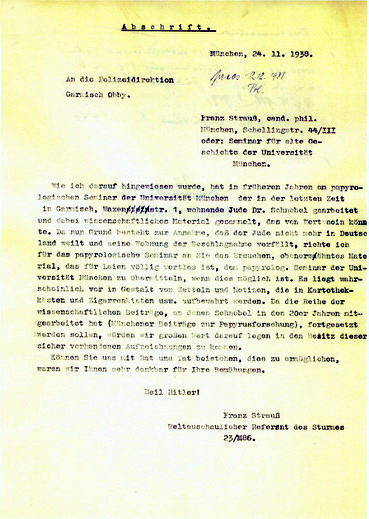
Letter from Franz Josef Strauss to the Garmisch-Partenkirchen Police Headquarters, November 24, 1938
https://www.gapgeschichte.de/juden_in_gap_biographien/schnebel_dr.michael_emma.htm
42 Michael und Emmy Schnebel
“We think it is better to die in the Fatherland”. Michael and Emmy Schnebel take their own lives in the Vorarlbergerhof
Feldkirch, November 13, 1938
On November 10, two travellers from Garmisch-Partenkirchen arrive in Feldkirch. They take a double room in the Hotel Vorarlbergerhof, next to the train station. On the evening of November 13, the hotel staff opens the room because the two guests have not been seen for two days.
That same evening, the gendarmerie post writes a report to the district administration:
“Feldkirch, November 13, 1938.
Dr. Michael Schnebel arrived here with his wife from Garmisch-Partenkirchen on November 10, 1938. Since they had no travel documents, they were prohibited from their intended departure to Switzerland. They rented a room in the Vorarlbergerhof. Since the people were last seen in the house on the evening of November 11, the locked room was opened today, November 13, at 7 p.m., and Schnebel and his wife were found dead in their beds.
The farewell letters found and four glass jars, each containing 10 pieces of veronal tablets, undoubtedly indicate suicide. The physician, Dr. Schwärzler, ordered the transfer of the bodies to the mortuary at the city hospital. Cash funds to cover funeral expenses are available.
The report was sent to the district administration, the public prosecutor's office in Feldkirch and the provincial gendarmerie command in Bregenz. (Not for the press!).“[1]


Michael and Emmy Schnebel
Michael Schnebel is 71 years old at the time of his suicide. Until 1930, he did worked at Munich University as a historian of ancient history and expert in papyrus research. Then he had retired to Garmisch-Partenkirchen with his wife Emmy.
Both were known for their self-deprecating humor and their love of German literature.
On November 10, 1938, a National Socialist mob marches through the streets of Garmisch-Partenkirchen. The Jewish inhabitants of the town are chased from their homes, insulted and spat upon. The Nazi district leader, Johann Hausböck, forces them to sign a lapel that they “leave Garmisch-Partenkirchen on the next available train and never return.” They must agree to sell their property, all “land, buildings and goods immediately from (their) new place of residence to an Aryan.”[2]
An SA man accompanies them to the train station. Michael and Emmy Schnebel were allowed to pack one more suitcase. Their apartment is sealed. An employee of the residents' registration office later notes on their registration card: “Since the Jewish Action unknown where moved to.”
In their farewell letter in the Feldkirch hotel room, the two write:
“It is best that we leave the world.” (...) “we consider it better to die in the fatherland than to be destitute in a foreign country. Like Cicero, we ask to be allowed to die in our fatherland.”[3]
They are initially buried in the Catholic cemetery of St. Peter and Paul, directly behind the hotel where they took their own lives.
A few days later, a student of the seminar for ancient history turns to the Garmisch-Partenkirchen police. On November 24, 1938, he writes:
“As it has been pointed out to me, in earlier years Dr. Schnebel, a Jew who has recently been living in Garmisch, Waxensteinstr. 1, worked at the Papyrology seminar of the University of Munich and collected scholarly material that could be of value. Since there is now reason to believe that the Jew is no longer in Germany and that his apartment is subject to confiscation, I request you, on behalf of the Papyrology seminar, to send the above-mentioned material, which is completely worthless for laymen, to the Papyrology seminar of the University of Munich, if this is possible. It is probably available in the form of slips of paper and notes stored in card file boxes and cigar boxes, etc. Since the series of scholarly contributions to which Schnebel contributed in the 1920s Munich Review of Papyrus research (Münchener Beiträge zur Papyrusforschung) is to be continued, we would attach great importance to coming into possession of these securely existing records. If you can assist us in word and deed to make this possible, we would be very grateful for your efforts. Heil Hitler!”
The 23 year old student Franz Strauß, who was so eager to obtain the scientific estate of Michael Schnebel, was apparently well informed about the expulsions from Garmisch, possibly also put on Schnebel's papers by his own doctoral advisor. In addition to his studies, he himself was active in the National Socialist Motorist Corps as an ideology consultant, called “Weltanschaulicher Referent”, in Sturm 23/M86. He became known not as a papyrus researcher, but as a long-time CSU chairman and Bavarian prime minister, under his full name Franz Josef Strauß.
Michael and Emmy Schnebel's last resting place should not remain in Feldkirch. A file note from the market town office in Hohenems and a note in the grave book of the St. Peter and Paul cemetery indicate that in April 1949 the remains of the two were moved to the Jewish cemetery in Hohenems. The exact location of their grave is unknown.[4]
Recommended reading:
Alfons Dür, “‘Es ist das Beste, dass wir aus der Welt gehen‘ - Der jüdische Althistoriker Dr. Michael Schnebel und seine Frau Emma Schnebel wählen am 14. November 1938 in Feldkirch den Freitod“, in: Montfort. Zeitschrift für Geschichte Vorarlbergs, 74th Jg., 2022, vol. 1, pp. 67-78.
[1] Incident report by the Feldkirch gendarmerie post command of 13.11.1938, VLA BH Feldkirch Abt. The Date is not clear. The typoscript shows the 14th later corrected into the 13th.
[2] https://www.gapgeschichte.de/juden_in_gap_biographien/schnebel_dr.michael_emma.htm
[3] Quoted after: https://www.gapgeschichte.de/juden_in_gap_biographien/schnebel_dr.michael_emma.htm
[4] Hohenems Municipal Archives Box 69 Number 123_11-B; St. Peter and Paul's burial book, Archive of the Diocese of Feldkirch.

Report of the Feldkirch Gendarmerie Post Command to the District Headquarters, November 13, 1938
Feldkirch District Administration, Dept. III, Incident Reports, 20-1938


